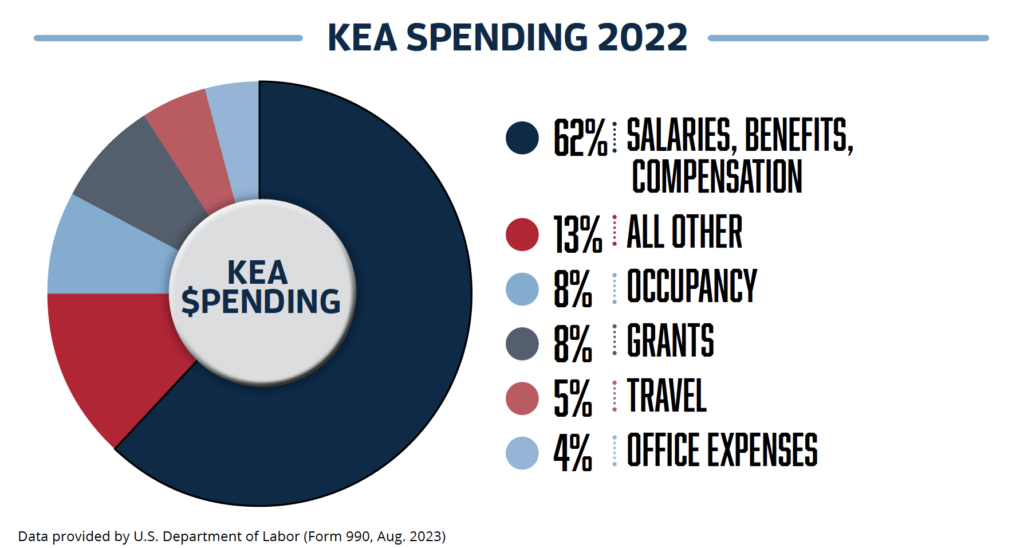The Kentucky Education Association (KEA) represents over 44,000 teachers and education professionals in Kentucky. The union is affiliated with the National Education Association (NEA), the country’s largest teachers’ union. As a non-profit organization, KEA must file a Form 990 financial disclosure. Examining KEA’s latest Form 990s helps to explain how the union spends its members’ dues.
KEA’s latest Form 990, which covers September 2022 through August 2023 (the 2022 reporting period), reveals that the union collected $7.4 million in membership dues. When compared to the two previous years, this represents a steep decrease. KEA collected $9.5 million in dues during the 2020 reporting period and $9 million during the 2021 reporting period. This $2 million drop in dues collections may be due, in part, to a legislative change that made KEA responsible for collecting dues by itself
rather than relying on employers to make payroll deductions. Though dues collections have significantly decreased, KEA’s spending has not. In 2022, the union spent a total of $10.8 million, compared to $10.9 million in 2020. Since revenue decreased and spending did not, KEA spent just over $1 million more than it took in during the 2022 reporting period. So, what is the union spending its members’ dues on?
Salaries, benefits, and other compensation for union employees was the top expense for KEA. In 2022, spending related to KEA employee compensation accounted for 62 percent of all expenses. KEA’s top earning employee, Executive Director Mary Ruble, earned $223,138 in total compensation, over 4 times more than the average public school teacher in Kentucky. Other top expenses for KEA include rent, grants to affiliated unions, travel, and office expenses.

KEA’S MEMBER DUES PAY FOR POLITICS
Though KEA does not report any expenditures on political activity or lobbying on its 2022 Form 990, the union is still heavily involved in politics. KEA’s website features a detailed “advocacy” section that outlines the union’s top priorities for the 2024 legislative session and state budget. KEA’s website makes multiple references to “KEA’s lobbying team,” indicating that the union is involved in lobbying.
KEA’s website also points members to the Kentucky Educators’ Political Action Committee (KEPAC). KEPAC collects contributions from KEA members and makes contributions to candidates for public office. According to KEA’s 2022 Form 990, the union collected roughly $310,000 in KEPAC contributions from its membership during the reporting period.
With these contributions, KEPAC made heavily one-sided political contributions to candidates seeking elected office in Kentucky. During the 2021-22 election cycle, KEPAC gave $226,000, or 94 percent of all contributions to Democratic candidates and causes compared to only $15,000, or 6 percent, for Republican candidates and causes. This 94 to 6 split is surely not representative of KEA’s membership. Notably, KEA gave:
- $100K to Kentuckians for Checks and Balances, a group with ties to Democratic Gov. Andy Beshar that opposed a ballot measure to allow the state legislature to extend or amend the state legislative session calendar.
- $50K to Kentuckians for Liberty and Justice, an independent expenditure committee that advocates for Democratic judicial candidates in Kentucky.